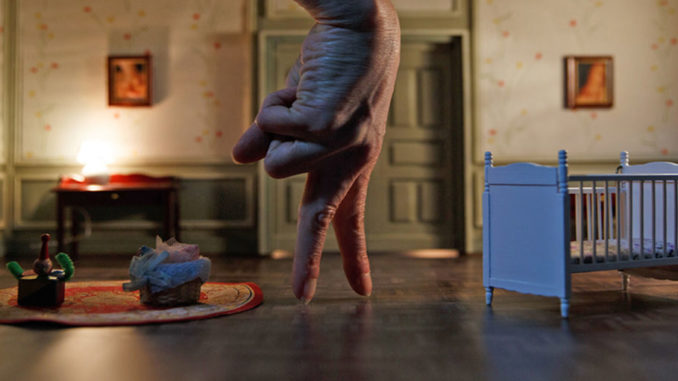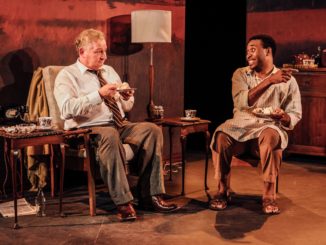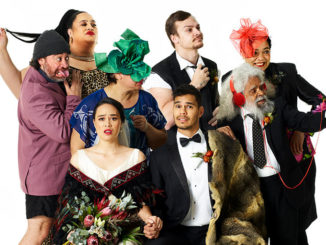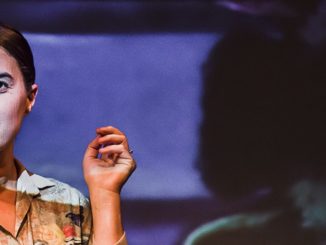
[Making the Strange Charming]
In the Belgian production Cold Blood, a team of camera and lighting technicians – with the help of detailed miniature sets, table-top puppetry techniques, and analogue special effects – recreate a series of scenes about death in full view of the audience which are then projected onto a screen hanging above the playing area. This is a clever, imaginative and charming production that takes audiences on a wonderfully weird and quirky journey and asks us to slow down, to observe, and to enjoy the small and often fleeting pleasures of life.
Devised back in 2015 by Belgian dancer Michèle-Anne de Mey and her film-making partner Jaco Van Dormael, the show began as a challenge to make a feature-length film on a kitchen table with a cast of dancing hands. Developed with the Kiss and Cry Collective, the production last night used the entire playing area of the Waterfront Theatre, using intricate miniature sets on rolling tables and table-top puppetry techniques using hands as figures. It’s like watching a Foley sound artist live – enacting a performance – but in Cold Blood it’s a team of camera operators, technicians, and set manipulators working with three dancers to animate miniature worlds in full view of the audience.
The show starts with a voice over (Toby Regbo as narrator) that hypnotises the audience before leading us through a series of seven deaths. We are told by the narrator that there are different types of deaths: there are gentle deaths, there are brutal deaths, suspicious deaths, violent deaths, slow deaths, premature deaths, and then there are stupid deaths. Each death scenario we encounter is beautifully executed but reveals a lasting memory or impression which is distilled into wonderful images. For example, the first death sequence involves an airplane crash in a forest. Miraculously all the passengers survive but one – a character we are told who instantly regretted his decision to visit the bathroom just before the plane crash. The first death is a stupid death. It is gentle and calm. As the actor playing the dead man stands upstage, we watch as the cast recreate the forest and crash site. The camera operator moves around a table covered in a miniature forest while a technician provides billows of dry ice to recreate the impression of mist. On the screen above the stage we watch as the camera pans in close up across the trunks of trees before revealing the slightly shocked figure of the dead man through the trees. Accompanied by beautiful instrumental music, we watch as dancers animate their hands in gentle waving motions in a tight beam of light that traverses the stage. The camera on the screen picks up the hand movements which appear as tree leaves floating down slowly onto the dead man and the forest floor. At this final moment of death, the narrator tells us, you expect to see your whole life go by but that’s not what happens. Only one image comes to mind: ‘For you, it’s not your wedding day or the medal you won in hockey. It’s the softness of a skin that one afternoon smelt of vanilla under your fingers like silk’. Here the scene transitions and we see the hand of the dead man as he caresses the slender back of a dancer.
Although film and digital technology are central to the production, there are so many beautiful moments in this production that are cleverly realised through detailed miniature sets and analogue effects. We see a baby room in a house, with a hand resting in a crib, animating a newborn baby. A door in the backwall opens, and the stagehands move the model room which is sitting on a platform towards the camera providing the effect on screen of a close-up zoom. The momentum continues into the next room where we encounter a hand representing a small child playing with a miniature football. The door in the backwall opens, and again we are transported into the next room where we see an ‘adult’ sitting in a rocking chair. We finally encounter a hand walking with a cane before the last door opens onto a grave. Using a hand to portray an aging character and a series of small model rooms that are pushed towards a camera, the scene eloquently recreates the journey of birth to death. It’s a magical moment that is both dark and funny, as we catch glimpses of hands framed as portraits on the walls of the tiny rooms which are magnified onto the projected screen.
Another memorable death occurs at the opera, as a couple watch a performance of ‘hands’ accompanied by Bolero’s Ravel. In the segment the camera rotates around a miniature stage on which hands represent dancers strutting rhythmically to the familiar snare drum. The camera operator continues to rotate, and on the screen we see the ‘backstage’ area of the miniature stage set before the live audience is revealed watching from the seats. At this moment in the production the houselights came up briefly and the crowd clapped and laughed at the ingenuity of the moment which at once plays with the skill and artifice involved in creating the scene while at the same time highlighting the illusion involved in the scene’s construction.
There is a wonderful juxtaposition in the staging that emerges between the staged elements and the illusion that is created on the projected screen. Yet with the exception of a couple of moments, most of the staging seems to be directed at creating and serving the cinematic illusion which, for me at least, emphasised a form of spectatorship that left me feeling a bit emotionally vacant. An exception is a scene where the dead character remembers the touch of a hand of the person he loves. In the scene, two performers sit at a café table that is lit from below. A close up captures the tentative movements of their hands which are magnified and projected onto the screen above the stage. But this moment is different because the projection appears for the first time as a backdrop to the two performers who are seated onstage together and who exhibit an emotional connection that was missing from much of the production. It’s not that there isn’t beauty and emotion in this production – I just found that I was marvelling at the technical proficiency much more than being emotionally moved and this might have something to do with the mode of spectatorship enforced through the privileging of the projected image.
The ‘effects’ that are used to make moments in the play visible onstage recalls the alienating approach of Brechtian theatre that attempts to make the familiar strange in order to open up the gap between appearance and reality as a precursor to social change. In Cold Blood the retelling of weird and wonderful stories about death and the ingenious use of technology and tabletop puppetry are subsumed to the cinematic presentation that encourages a mode of spectatorship that is about wonder and spectacle. It is a show that makes the strange not so much familiar but charming but as such avoids questions of social inequality or injustice. But maybe being charmed is social change enough?
Cold Blood plays the ASB Waterfront Theatre as part of the Auckland Arts Festival, 11-14 March, 2020.
by Michele Anne De Mey, Jaco Van Dormael, and the Kiss & Cry Collective. Text by Thomas Gunzig. Directed by Jaco Van Dormael.




Just want to chip in that I found the level of craft overwhelmingly flawless but similarly cold and alienating too. It’s strange to be so impressed by something and also unmoved by it at the same time. Like being behind-the-scenes in a film studio. Still, never seen anything quite like it. The deadpan quality of the morbid narration was also pitch perfect.